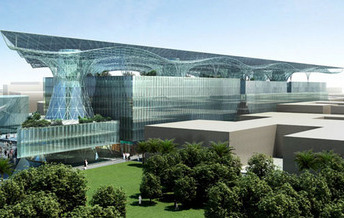
The lone U.S. finalist in the World Architecture News competition to find the world’s most sustainable building emerged triumphant when the winner was recently named. The Bullitt Center in Seattle’s Capitol Hill neighborhood won the coveted title over five other finalists from around the world.
The Bullitt Center was constructed in 2013 with cutting edge principles in the sustainable architecture field. It, naturally, serves as the headquarters of an environmental foundation with deep green roots, and has space for other tenants. One of its local claims to fame is its inclusion of a bicycle garage and exclusion of a vehicle garage, a bold but brilliant move by the sustainable design architects who worked on the project.
Given its heritage, it’s not surprising that the Bullitt Center would vie for most sustainable honors. Denis Hayes, co-founder of the first Earth Day, serves as president of the Bullitt Foundation, which oversaw the building’s development. The foundation and building are named for Harriet Bullitt, a philanthropist, who was the primary source of funds for the project. The foundation was helped every step of the way by the mayor of Seattle and other city officials, in a model of private-government partnership for green architecture.
In accepting the award, Hayes cited the Miller Hull firm for its role. The Seattle firm, one of several green architecture firms in the city, used local materials and built the building to interact seamlessly with the local, unique climate. Seattle is known as a city low on sunlight with frequent cloud cover and rain.
Among the achievements of the sustainable building cited by the World Architecture News committee were:
• Its place as the first building aimed at the leasing market that meets international targets for a living building and zero net energy usage.
• The refusal of its green architects and builders to use any toxic chemicals in its construction, including asbestos, lead, cadmium and chlorofluorocarbons.
• Its stunning ability to not only have zero energy usage, but to give back to the city. Built in a way that 100% of its energy needs are met on site, through the use of renewable energy on a net annual basis, the Bullitt Center actually feeds more energy into the Seattle City Light grid than it uses. Sensors that monitor light levels, CO2, temperatures, wind and sun, created by the green architecture firm that oversaw the project, make this zero energy usage possible.
• The outstanding cooperation of a variety of players in the project, including local government, public agencies and a multidisciplinary green architecture design team.
How to find sustainable architects for your own project
Hayes and other green advocates do not want to stop with the Bullitt Center in their quest to make Seattle an even greener city. Upon receiving the award, he said that he hoped the building would transform the construction industry in Seattle and around the world.
If the thought of building a similarly green project thrills you, find a sustainable architect in this site and find out if your vision can become a reality, as the Bullitt Center did.

Comments by our Users
Be the first to write a comment for this item.